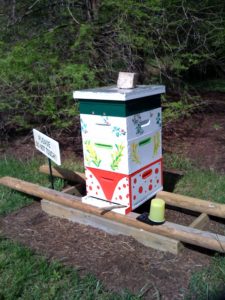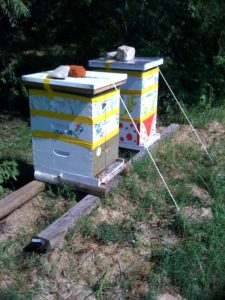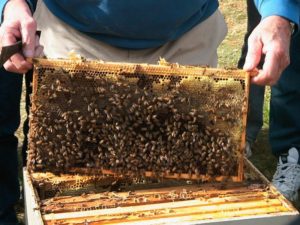The Apiary Blog — Bees at Leas
Background — In March 2009 the Arboretum Committee of the Estaugh Board received a proposal for an apiary at Medford Leas. Details, including the credentials of beekeeper Corey Melissas, were reported in the May 2009 issue of Medford Leas Life. Corey, who has given mlra.org permission to reproduce her newsletters here, blogged in August 2009 about the hive that she had installed on the Lumberton campus:
Hi’ve Been Busy — August 2009
Corey MelissasIt’s been a busy couple months, and we’ve reached a milestone. The honeybees have been doing extremely well, growing in number, still amazingly calm and gentle. From egg to pupae to emergence as a worker bee, takes 21 days. In the summer, hard working worker bees typically live 45 days at most, which brings us to 66 days total, that’s today. Every honey bee in our hive is officially a Lumberton Leasian. Continue reading…
In September 2009 Medford Leas Life reported that the hive was in place on the Lumberton Campus and provided more details about the hive and the work of beekeeping which Corey had undertaken. In May 2010 there was a report in Medford Leas Life based on a newsletter about the hive which Corey wrote in April:
Hi’ve Been Busy — April 2010
Corey MelissasI almost couldn’t wait, but around the third week of March I opened the hive on a very warm day to find them happy and plentiful. The entire first level [hive body] was empty of bees, brood and honey. The upper body was filled with all the bees and a few frames of untouched capped honey. This is good news because it means they were able to store enough honey on which to live through the winter. If you remember, this was the first year goal. Continue reading…
Corey continued her blog in May:
Hi’ve Been Busy — May 2010
Corey MelissasHey! Someone`s been eating out of my feeder!
The only, yet unanimous, complaint I received from my bee neighbors was how much the honey bees were robbing their hummingbird feeders. One resident said he actually watched the bubbles rise like an emptying office water cooler. Hummingbird watching is a very popular pastime here and everyone has a feeder. For fear of having to relocate in August, a little research yielded the following. Continue reading…
In April 2011 a hive was installed on the Medford Campus. Betsy Pinnink wrote an article for the June 2011 issue of Medford Leas Life.
Beehive Arrives
Text and photos by Betsy Pinnink
After Ro Wilson found out that Lumberton Leas had a beehive (Medford Leas Life, May and September 2009 and May 2010), she campaigned to get one here. It has arrived!
Corey continues to come back to the apiary. She has brought another box to put directly on top of the first, an upper story so to speak, with more frames hung in it. (Frames are flat panels on which bees build their wax cells to hatch eggs and store honey. Frames are hung side by side in the box.) The bees are already at work there and may need a third story or “super” when the nectar flow is “in full swing.” Continue reading…

In the October 2011 issue of Medford Leas Life, Betsy Pennink’s article (below) told of the visit by a reporter from The Philadelphia Inquirer who took a video of the state inspector checking the bees at the Lumberton Campus. (Note: this video is currently unavailable on the Inquirer website, but there is a later article about him, including a visit with Corey.) In the same issue an article about Hurricane Irene showed a picture of the hives taped and tied down in preparation for the storm.
Happy Honeybees
by Betsy PinninkIt’s hard to tell who’s been busier this summer, the honeybees on our Medford campus or Corey Melissas, the beekeeper. Because our worker bees have been out foraging all day, there’s little activity around our hives until evening, when many of them congregate around the entrances.
Finding Corey has become more difficult, because she is actively tending her six beehives, five of them some distance from her home in Cherry Hill. Two of these are here in Beaver Meadow. Corey brought us the first one in April this year (see Medford Leas Life of June 2011) and the second one soon after. She had had to rescue this second one from its site near a meadow when a weed killer was sprayed there before the planting of a corn crop. Both our hives are thriving, says Corey, because “the bees are happy!” And producing honey! Corey has been harvesting the honey regularly and selling it to family and friends. Continue reading…


Corey’s 2015 newsletter provides detail about the work which must be done for hives and colonies to survive and thrive.
Hi’ve Been Busy — October 2015
Corey MelissasLast year was my personal best as far as beekeeping goes. I answered 20+ swarm calls, had no dead outs, and harvested the most honey since I started in 2008. 2015’s goal was to get all my hives into a standard sized hive body with new Freeman Beetle Trap bottoms, and replace any comb of poor quality or over 5 years old. Sounds simple enough.
Winter is time to repair and replace equipment. I spent hours scraping off old, hard, dirty comb, and replacing it with nice, clean, fresh, soft {pesticide free} wax. January is also time to pay your NJBA dues, renew your Jersey Fresh license, and update your status at the NJ Dept of Agriculture: this update, the NJBA believes, should include your availability to answer swarm calls. Great! I have all this new wax to be drawn out and feral swarms are terrifically motivated comb builders.
Building out comb is a lot of work. My plan was to get the swarms to draw out my new foundations and slowly integrate it into my existing hives that were busy pollinating, raising young, etc. Eventually leaving the swarms with their own space. Sounds simple. Continue reading…
